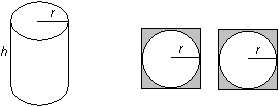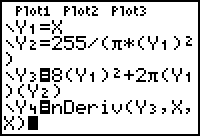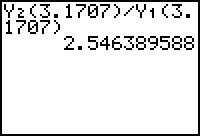In Lesson 14.2 you investigated when the surface area of a can was minimized. In this lesson you will explore the more realistic problem of finding when the amount of material used in making the can is minimized.
The Problem
A can is made from a rectangular piece that forms the lateral surface and two circles cut from square pieces that form the top and bottom. The volume of the can is to be 255 cubic centimeters. The following discussion will find the radius of the can and the ratio of height to radius when the amount of material used is minimized.
The Diagrams
The diagrams below illustrate a can of height h and radius r with the top and bottom cut from square pieces of material.

Although the shaded area is not part of the can, it must be included in the material used.
Material Used as a Function of Radius and Height
The amount of material used is the sum of the areas of the two squares that are used to create the top and bottom and the rectangle that is used for the lateral area. The length of the sides of the squares is 2r and the rectangle's sides are 2
![]() r and h, so the material used to create the can is given by:
r and h, so the material used to create the can is given by:
= 8r2 + 2
Radius and Height as Functions of x
The material used is a function of two variables, r and h. The variables r and h should both be defined in terms of x so that the material function can be written as a function of one variable.
The desired volume is 255 cubic centimeters and the formula for volume is V =
![]() r2h. Therefore,
r2h. Therefore, ![]() r2h.
r2h.
Solving the equation for h gives
Letting r = x, r and h can both be defined as functions of x.
r(x) = x
h(x)=255/(
![]() *(r(x))2)
*(r(x))2)
These functions can be entered in the Y= menu. Define r(x) in Y1 and h(x) in Y2, letting Y1 represent r.
- Enter Y1 = X.
-
Enter Y2 = 255 / (
 * (Y1) 2 ).
* (Y1) 2 ).
- Unselect Y1 and Y2.
Recall that the function that represents the material used is M = 8r2 + 2
![]() rh. Define the function for the material used in Y3 letting Y1 represent r and Y2 represent h.
rh. Define the function for the material used in Y3 letting Y1 represent r and Y2 represent h.
-
Enter Y3 = 8(Y1)2 + 2
 (Y1)(Y2).
(Y1)(Y2).
The Derivative of Material used with Respect to x
Store the derivative of the material used in Y4.
- Enter Y4 = nDeriv(Y3,X,X).

The Zero(s) of the Derivative
The domain of the material used function is x > 0. As before, experiment with different viewing windows to better understand the graphs of the function and its derivative. You will see that the derivative appears to only have one zero. Find the approximate value of the zero of the derivative.
- Display the graphs of the material used and its derivative in a [0, 7, 1] x [-200, 400, 50] window.
- Use the Zero feature to find the zero of the derivative.

The critical point is x
![]() 3.1707, which represents the radius of the can. It is good practice to store all the decimals found for x in the above figure before calculating the colrresponding height. The figure below shows the value found for x stored into A and the corresponding height computed. The corresponding height is approximately 8.0740, which is found by evaluating Y2(A).
3.1707, which represents the radius of the can. It is good practice to store all the decimals found for x in the above figure before calculating the colrresponding height. The figure below shows the value found for x stored into A and the corresponding height computed. The corresponding height is approximately 8.0740, which is found by evaluating Y2(A).

|
|||
|
|
|||
Other Possible Extreme Values
The first derivative is defined everywhere in the function's domain, so x
![]() 3.1707 is the only critical point. There are no endpoints to consider. We can pin these facts down by finding an analytic formula for the function and its derivative. We could also use their graphs to support this information.
3.1707 is the only critical point. There are no endpoints to consider. We can pin these facts down by finding an analytic formula for the function and its derivative. We could also use their graphs to support this information.
The Second Derivative
We can also use the second derivative test to check the information found above. Test the critical point in the second derivative of the material used to justify that it represents a local minimum.
- Enter nDeriv( Y4, X, 3.1707) on the Home screen.

Because the second derivative of the material used is positive at x
![]() 3.1707, the graph of the function is concave upward and has a local minimum value there.
3.1707, the graph of the function is concave upward and has a local minimum value there.
Because there are no endpoints and no other critical points, the local minimum value is the absolute minimum value.
The Ratio of Height to Radius
Evaluate the ratio of height to radius,
![]() , at the zero of the derivative.
, at the zero of the derivative.
- Enter the command Y2(3.1707) / Y1(3.1707) on the Home screen.

The ratio of height to radius for the can with minimum material used appears to be approximately 2.5464. We can improve this approximation by using all the decimals that the calculator finds for the zero of the derivative.
14.3.1 Change the volume of the can to 355 cubic centimeters. Find the zero of the derivative of the material used function for the new can and find the ratio of height to radius at that point. Compare the ratio of height to radius of the can that holds 355 cubic centimeters to that of the can that holds 255 cubic centimeters.
Click here for the answer.
The Generalized Can With Waste Problem
It can be proven that the ratio of height to radius for the can in this lesson is
![]() for any fixed volume.
for any fixed volume.